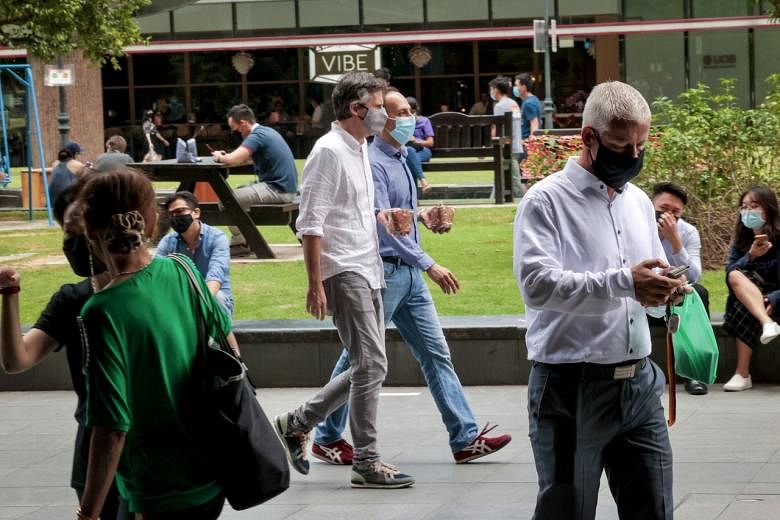SINGAPORE - In an essay on justice, the philosopher John Rawls described equal opportunity thus: "Those who are at the same level of talent and ability, and have the same willingness to use them, should have the same prospects of success regardless of their initial place in the social system".
Today, this ideal has been corroded in many countries around the world. The perceived absence of equality of opportunity - and an erosion of people's sense of mutual obligation and trust - lies at the heart of deep public disaffection in such places.
How should the playing field be levelled? What is a fair bargain between individual and collective responsibility? These questions were answered through the sweeping set of measures announced by Finance Minister Lawrence Wong on Friday (Feb 18) in an expansionary $109 billion Budget.
Beyond a statement of revenue and expenditure, it was a statement of intent about what it means to be Singaporean, and what kind of society Singapore should be: one that provides minimum economic security for all, maximum investment in capabilities throughout one's life, and a broader sharing of risk.
How so? There are too many areas to cover in this analysis, so I will touch on just three of them.
First, those who earn more should contribute more, particularly through changes to the tax system, with the revenue generated used to mitigate social inequalities.
The idea of taxing those who are wealthier has gained momentum in recent years, amid concerns about a widening income gap and the younger generation being priced out of the property market.
But the Government has generally been cautious about making large moves on this front, given the risks to Singapore's international competitiveness. Also, given that the personal income tax rate for top tier earners was raised from 20 to 22 per cent just five years ago, not everyone expected another hike to take place this soon.
Yet, it did - the portion of chargeable income in excess of $500,000 up to $1 million will be taxed at 23 per cent, and that in excess of $1 million at 24 per cent.
There are three ways to tax wealth: when it is passed on to the next generation through an inheritance tax, income from wealth such as capital gains or dividends, or people's stock of wealth through property taxes.
The Government chose the latter, with the hike hitting larger and more centrally-located private properties the hardest. This was the most sensible option on the table, since immovable properties are less prone to capital flight and harder to plan away for tax.
Concurrently, amid inflationary pressures and rising prices, the goods and services tax (GST) increase will be delayed to 2023 and staggered over two stages, with more support for the less well-off and GST continuing to be absorbed on publicly subsidised healthcare and education.
Second, achieving fairer outcomes through the labour market. This has the added advantage of reducing the need for benefits payments and the taxes that pay for them.
For example, firms will be encouraged to further reduce their reliance on foreign manpower, through the raising of qualifying salaries for new Employment Pass and S Pass holders.
The EP minimum qualifying salary will be raised from $4,500 to $5,000, among other moves. In the financial service sector, where the salaries are higher, this amount will go up to $5,500 from the current $5,000. There will also be refinements to how EP applications are assessed.
Friday's announcement will not satisfy those who argue that the use of salary thresholds is a blunt instrument that does not take into account specific skills requirements, or the concentration of nationalities in a firm. A points system which considers a range of non-salary factors, they say, could make the EP approval process more transparent.
Indeed, the current system is not perfect. But the raising of salary thresholds over time will go some way towards incentivising employers to hire locals, spur job redesign and higher wages and productivity, ensure the quality of foreign manpower, and attract more Singaporeans into sectors hitherto dominated by foreign labour.
Third, uplifting lower-wage workers. The Progressive Wage Model (PWM) will be expanded to more sectors, and to help firms adjust to higher costs, there will be transitional support for employers implementing Progressive Wage moves by co-funding these workers' wage increases.
There will also be enhancements to the Workfare Income Supplement (WIS) Scheme, such as an increase in the qualifying monthly income cap, extension of Workfare to those aged 30 to 34, and allowing all persons with disabilities to qualify for the highest Workfare payout tier regardless of age.
The PWM and WIS schemes are neither new, nor are the announcements all new. But the mere act of expanding their coverage is a significant one.
The WIS is a key pillar of social support, and since it was introduced in 2007 has been effective in incentivising less-educated, lower-skilled, and older Singaporeans to enter and stay in the workforce.
But extending it to younger workers could be an acknowledgement of several inter-related issues: that outdated skills alone may not be enough to explain lagging incomes; that the problem of lagging incomes is not limited to the older demographic; and that market-determined wages may be too low not just for older workers, but for lower-wage workers in general.
As Mr Wong said, the moves on progressive wages will cover around 94 per cent - or almost all - of full-time lower-wage workers. Through a combination of progressive wages and Workfare, the incomes of lower-wage workers are expected to grow faster than the median wage growth over the next decade.
What else would I have liked to see more of?
First, more details of investments in capabilities. What does the new scheme for larger firms to scale up and invest overseas involve, given that there have been similar overseas expansion initiatives?
What exactly does "making company attachments for mature mid-career workers a permanent feature of the training and placement ecosystem" mean? Ditto for the kinds of employment facilitation services that will be provided under the subsidised SkillsFuture Career Transition Programme.
Second, more protection for all workers regardless of the type of employment contract they have, including minimum benefits such as sick leave and some form of unemployment insurance or transitional salary support.
Third, more support for childcare and eldercare. Unlocking talent goes beyond easing mature workers into jobs, or rebalancing the proportions of foreigners and locals. How will women, who currently form the bulk of unpaid caregiving labour, be enabled to be more productive in the workforce?
No doubt, the public will continue to be fixated - and divided - on the issue of taxes. But as the Finance Minister put it, every dollar collected flows back to taxpayers in one way or another - from seniors' Silver Support payments to Workfare payouts, to healthcare and childcare subsidies, and quality education which every child receives. It is also reflected in the infrastructure and development around us, from roads and hospitals to schools and parks.
"No one likes to talk about taxes. But there are no painless solutions. Ultimately, every need must be paid by someone - every dollar not paid by one person will have to be made up by someone else, either today or in the future," Mr Wong said.
Friday's Budget demonstrates that the provision of minimum protection around some risks such as sickness, unemployment and old age are better shared by society, instead of asking individuals, families or employers to bear the burden alone - which has resulted in the highly unequal outcomes that we have seen throughout history.
We must take an interest in one another's well-being. We can - and must - expect that those with more will contribute more. Such a fair and progressive system reflects who we are as society. It reflects our values, and it is how Singapore will strengthen its social compact.


